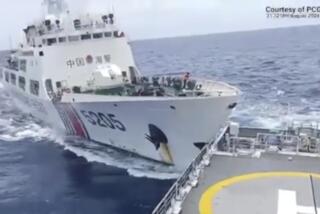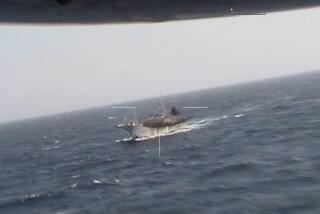In a disputed reef, Philippines sees face of Chinese domination
- Share via
MASINLOC, Philippines — The fishermen were sailing the azure waters off the Philippine coast when Richard Caneda saw the morning sunlight glinting off a vessel “bigger than the biggest ship in the Philippine navy.”
Caneda could see a red Chinese flag. The words “Chinese Maritime Surveillance” were written on the ship’s side.
The ship came close enough that Caneda could see crew members on deck making hand gestures as though to shoo away a fly. Caneda, who had moved from the fishing boat to a tiny skiff to haul in nets left out overnight, soon saw a large gun mounted on the ship’s deck pivoting directly toward him. A helicopter whirred overhead.
The fishermen fled, leaving their nets and catch behind.
“We were scared. We were angry. We were frustrated. That is our livelihood,” Caneda, 34, a now-unemployed father of three who lives in a shantytown in Masinloc, said of the November encounter.
It happened near the reef known as Scarborough Shoal, 130 miles off the coast of the Philippines’ largest island, Luzon, and barely 200 miles from Manila, the Philippine capital. Claimed by both China and the Philippines, the mostly underwater reef has come to represent the dangers of Chinese expansionism.
“Scarborough today — tomorrow the world,” read banners at an anti-China demonstration last year in Manila.
In its quest to become a maritime power and to tap potential undersea oil and gas reserves, China is asserting sovereignty over various islands, rocks and reefs dangerously close to the shores of Japan, South Korea, Malaysia, Brunei, Vietnam, Indonesia and the Philippines.
Beijing and Taipei, Taiwan, condemned the Philippines on Friday for the shooting death of an unarmed 65-year-old Taiwanese fisherman in the disputed waters of the South China Sea. Philippine authorities said a coast guard ship fired on the Taiwanese vessel a day earlier in an area to the north of Luzon, but only in an attempt to disable the engine to prevent being rammed.
On Wednesday, the Philippines issued an official apology in a response to a midnight deadline set by Taiwan, which had threatened economic retaliation.
Along with Japan’s Senkaku islands (known as Diaoyu to the Chinese), the Scarborough Shoal is the area’s most hotly contested territory, the scene of dozens of too-close calls during the last year.
For more than a year, Chinese ships have patrolled Scarborough Shoal, chasing away Philippine fisherman and maintaining what Philippine Foreign Secretary Albert del Rosario calls “a de facto occupation.”
Despite pledges of neutrality from Washington, the dispute could easily entangle the United States, resurrecting Cold War alliances and putting to the test the Obama administration’s so-called pivot toward Asia.
For most of the 20th century, the U.S. Navy had its largest overseas base at nearby Subic Bay in the Philippines, and the Navy used to conduct firing exercises at Scarborough Shoal. Feeling that the Americans had worn out their welcome, Manila asked the Navy to leave in 1992. But last year, a few U.S. vessels were readmitted on a rotating basis, and Filipinos increasingly are expressing regret about the American departure.
“If the Americans were still at Subic Bay, the Chinese wouldn’t dare do this to us,” Caneda said.
In January, the Philippines asked a United Nations tribunal to determine the status of the reef. But the process could take years, and China has indicated it will not abide by the decision.
In the meantime, the Philippines finds itself outgunned, outmaneuvered and outspent. The Chinese have run a rope across the mouth of a lagoon inside the triangular-shaped shoal, where Filipinos have fished for generations, and in recent weeks have declared a 15-mile fishing ban around the reef.
The dispute has devastated the fragile economy of the fishing communities in coastal Luzon. The shoal used to attract so many fishing boats that at night with their lights shining, it looked like an illuminated city at sea.
Fishermen say the shoal was where they went to get the biggest and best fish: Spanish mackerel, Pacific cod, tuna and lapu lapu, a giant grouper. A 25-man ship could bring back $17,000 worth of fish in a single trip.
“The income from fishing is cut in half,” said Julius Sumaling, a fishing boat captain who says it’s not worth the gas anymore to go out with his ship, the San Pedro, now docked south of Masinloc, a town of 51,000 on the coast.
Joseph Morate, who sells squid at the main market in Masinloc, said he took his 15-year-old daughter out of school because he could no longer afford the $4 a day in transportation costs and needed her to baby-sit younger children.
“All I have to sell is squid because the Chinese are chasing us away from the quality fish,” Morate said.
At the main market, many of the white tile tables where fish used to be displayed are now mostly empty or used by vendors selling meat.
Luz Farones Macario, whose husband runs one of the biggest fishing fleets in Masinloc, with three large boats, now sells frozen chicken legs, ham and sausage.
“All of these aisles were full of fish. Now, no more,” she said. “Why are the Chinese being so selfish when there is so much fish in the sea?”
According to Filipinos, the generations of fishing at the shoal were interrupted only when the reef was used as a firing range. It is more than 500 miles from the southern tip of China’s southernmost island, Hainan.
Beijing, however, has produced records showing that the territory was explored and charted as far back as 1279 by the 13th century astronomer Guo Shoujing, who surveyed the region for the emperor Kublai Khan.
China has produced a U-shaped map that gives it sovereignty over almost all the South China Sea up to the borders of Vietnam, Malaysia, Brunei and Indonesia.
Shen Dingli, an international relations expert at Shanghai’s Fudan University, says the Philippines did not actively assert its claim to the shoal until 1992.
“For a long time, China has claimed all rocks in the entire South China Sea,” Shen said, speaking at an international conference last week in Seoul. “Prior to 1992, the Philippines made no official disagreement, so we view it as a virtual admission of China’s claim.”
The Chinese have also denied using force, saying the ships it dispatches belong only to China Marine Surveillance and the Fisheries Law Enforcement Command, civilian agencies that are not supposed to carry weapons. Photographs in Chinese state media, however, clearly show some of the marine surveillance ships with guns mounted on their decks.
Experts in maritime law say part of the issue is that China is a much older country than its neighbors, with a more meticulous system of record-keeping.
“The Philippines didn’t even have a central government until Spanish colonial times,” said Carlyle Thayer, professor emeritus at the Australian Defense Force Academy. “The local Malay people didn’t keep records the way the Chinese did.
“But the fact that you have records doesn’t extinguish the rights of the native people,” Thayer said.
The name Scarborough comes from a boat that was shipwrecked there in 1784. Filipinos also call it the Bajo de Masinloc — a name that dates to Spanish colonial times — while the Chinese have named it Huangyan, or “Yellow Rock.”
By many accounts, the reef was a favorite fishing spot for numerous groups for years, and relations were friendly enough that fishermen often bartered goods — Chinese liquor and instant noodles for Philippine mangoes and papaya.
The current spat dates to April 11, 2012, when Chinese fishermen were accused of poaching giant clams and sharks, protected species. The Philippines sent a naval ship to arrest the Chinese fishermen, who in turn radioed for help from China Marine Surveillance.
After a two-month standoff, a deal was brokered by the United States for both sides to withdraw from the shoal.
The Chinese never left.
More to Read
Sign up for Essential California
The most important California stories and recommendations in your inbox every morning.
You may occasionally receive promotional content from the Los Angeles Times.










